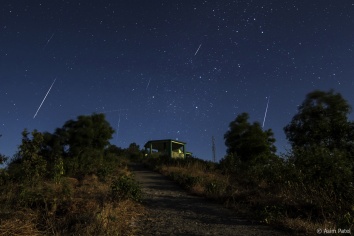
Geminid meteor shower in 2013. Credit: Asim Patel.
20 November 2023
This will be a great year to view the Geminid meteor shower. It is expected to peak the night of December 13/14. That is close to the new moon on December 12, meaning there will be little moonlight to interfere with the show. The full duration of the Geminids is November 19 to December 24.
The Geminids are usually the strongest meteor shower of the year, with up to 120 meteors an hour visible under optimal viewing conditions. Geminid meteors are slow-moving, bright, and abundant, making the shower a fan favorite.
McDonald Observatory is not hosting any special activities for the Geminids. But if you find yourself in the area, the low levels of light pollution in the Greater Big Bend International Dark Sky Reserve within which we reside make it an excellent spot to experience this and other sky watching events.
The Geminids At a Glance
When and Where to Look
The Geminids will peak around 2:00 a.m. on the morning of December 14. That’s when the radiant of the meteor shower – the point from which the meteors appear to "rain” into the sky – will be highest in the sky. For the Geminids, that point is near the constellation Gemini (hence the shower’s name). However, you don’t need to find Gemini to enjoy this shower. Meteors will be visible throughout the sky, and throughout the night.
To See More Meteors, Seek Darkness
For best viewing, find a spot well away from the glow of city lights. Lie back or position yourself so the horizon appears at the peripheral edge of your vision, with the stars and sky filling your field of view. Enjoy!
White light, such as from a cell phone or standard flashlight, can make it hard for your eyes to adjust to the dark. Instead, we recommend using a red light to get around as it will not interfere with your night vision. We also recommend viewing the shower from a location where oncoming car headlights will not shine your way.
Visit StarDate.org for more meteor shower tips.
What Causes the Geminids?
Unlike most meteor showers, the Geminid shower is the product of an asteroid, rather than a comet. The asteroid responsible for the Geminids is 3200 Phaeton.
Both asteroids and comets orbit our Sun. Asteroids are big hunks of rock mixed with ice, whereas comets are big balls of ice mixed with some rock. As a comet approaches the Sun, ice and debris vaporize off of it to form a tail. Asteroids don’t sprout visible tails. However, as is the case of 3200 Phaeton, they can have a tail of debris following in their wake.
When Earth passes through the tail of a comet or asteroid, that tail’s debris burns up in our atmosphere. The result is a beautiful meteor shower.
Tag Us on Social
If you capture any pictures of the Geminid meteor shower, we’d love to see them! Tag McDonald Observatory on Facebook, Instagram, and Twitter (X).

Geminid meteor shower in 2013. Credit: Asim Patel.